A Christmas Carol
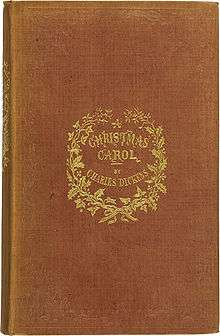 First edition cover (1843) | |
| Author | Charles Dickens |
|---|---|
| Original title | A Christmas Carol. In Prose. Being a Ghost Story of Christmas. |
| Illustrator | John Leech |
| Country | England |
| Genre | Novella |
| Published | 19 December 1843 (Chapman & Hall) |
| Media type | |
| Text | A Christmas Carol at Wikisource |
A Christmas Carol in Prose, Being a Ghost-Story of Christmas,[1] commonly known as A Christmas Carol, is a novella by Charles Dickens, first published in London by Chapman & Hall on 19 December 1843.[2] The novella met with instant success and critical acclaim. A Christmas Carol tells the story of a bitter old miser named Ebenezer Scrooge and his transformation into a gentler, kindlier man after visitations by the ghost of his former business partner Jacob Marley and the Ghosts of Christmas Past, Present and Yet to Come.
The book was written at a time when the British were examining and exploring Christmas traditions from the past as well as new customs such as Christmas cards and Christmas trees. Carol singing took a new lease of life during this time.[3] Dickens' sources for the tale appear to be many and varied, but are, principally, the humiliating experiences of his childhood, his sympathy for the poor, and various Christmas stories and fairy tales.[4][5][6]
A Christmas Carol remains popular—having never been out of print[6]—and has been adapted many times to film, stage, opera, and other media.
Background
Dickens was not the very first author to celebrate the Christmas season in literature,[4] but it was he who superimposed his humanitarian vision of the holiday upon the public, an idea that has been termed as Dickens' "Carol Philosophy".[7] Dickens believed the best way to reach the broadest segment of the population regarding his concerns about poverty and social injustice was to write a deeply felt Christmas story rather than polemical pamphlets and essays.[8][9] Dickens' career as a best-selling author was on the wane, and the writer felt he needed to produce a tale that would prove both profitable and popular. Dickens' visit to the work-worn industrial city of Manchester was the "spark" that fired the author to produce a story about the poor, a repentant miser, and redemption that would become A Christmas Carol.[10]
The forces that inspired Dickens to create a powerful, impressive and enduring tale were the profoundly humiliating experiences of his childhood, the plight of the poor and their children during the boom decades of the 1830s and 1840s, and Washington Irving's essays on old English Christmas traditions published in his Sketch Book (1820);[11] and fairy tales and nursery stories, as well as satirical essays and religious tracts.[4][5][6]
Childhood experiences
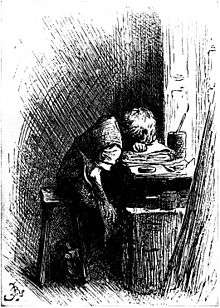
While Dickens' humiliating childhood experiences are not directly described in A Christmas Carol, his conflicting feelings for his father as a result of those experiences are principally responsible for the dual personality of the tale's protagonist, Ebenezer Scrooge. In 1824, Dickens' father, John, was imprisoned in the Marshalsea whilst 12-year-old Charles was forced to take lodgings nearby, pawn his collection of books, leave school and accept employment in a blacking factory.[4][12]
The boy had a deep sense of class and intellectual superiority and was entirely uncomfortable in the presence of factory workers who referred to him as "the young gentleman". As a result of this treatment, he developed nervous fits. When his father was released at the end of a three-month stint, young Dickens was forced to continue working in the factory, which only grieved and humiliated him further. He despaired of ever recovering his former happy life.[4][12]
The devastating impact of the period wounded him psychologically, coloured his work, and haunted his entire life with disturbing memories. Dickens both loved and demonised his father, and it was this psychological conflict that was responsible for the two radically different Scrooges in the tale—one Scrooge, a cold, stingy and greedy semi-recluse, and the other Scrooge, a benevolent, sociable man, whose generosity and goodwill toward all men earn for him a near-saintly reputation.[13] It was during this terrible period in Dickens' childhood that he observed the lives of the men, women, and children in the most impoverished areas of London and witnessed the social injustices they suffered.[4][12]
Children living in poverty

Dickens was keenly touched by the lot of poor children in the middle decades of the 19th century.[14] In early 1843, he toured the Cornish tin mines, where he saw children working in appalling conditions. The suffering he witnessed there was reinforced by a visit to the Field Lane Ragged school, one of several London schools set up for the education of the capital's half-starved, illiterate street children.[15]
Inspired by the February 1843 parliamentary report exposing the effects of the Industrial Revolution upon poor children called Second Report of the Children's Employment Commission, Dickens planned in May 1843 to publish an inexpensive political pamphlet tentatively titled, An Appeal to the People of England, on behalf of the Poor Man's Child, but changed his mind, deferring the pamphlet's production until the end of the year.[16] He wrote to Dr. Southwood Smith, one of 84 commissioners responsible for the Second Report, about his change in plans: "[Y]ou will certainly feel that a Sledge hammer has come down with twenty times the force—twenty thousand times the force—I could exert by following out my first idea". The pamphlet would become A Christmas Carol.[17]
In a fundraising speech on 5 October 1843, at the Manchester Athenæum, Dickens urged workers and employers to join together to combat ignorance with educational reform,[8][18] and realised in the days following that the most effective way to reach the broadest segment of the population with his social concerns about poverty and injustice was to write a deeply felt Christmas narrative rather than polemical pamphlets and essays.[8][9] It was during his three days in Manchester that he conceived the plot of A Christmas Carol.[8][19]
Washington Irving's Christmas stories
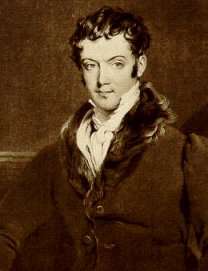
Irving's The Sketch Book of Geoffrey Crayon, Gent. (1819–1820) was written over 20 years before A Christmas Carol. The Sketch Book depicted the harmonious warmhearted English Christmas traditions that Irving had experienced while staying at Aston Hall. The tales and essays attracted Dickens,[4] and the two authors shared the belief that the staging of a nostalgic English Christmas might restore a social harmony and well-being lost in the modern world.[20] In "A Christmas Dinner" from Sketches by Boz (1833), Dickens had approached the holiday in a manner similar to Irving, and, in The Pickwick Papers (1837), he offered an idealised vision of Christmas at Dingley Dell.[20] In the Pickwick episode, a Mr. Wardle relates the tale of Gabriel Grub, a lonely and mean-spirited sexton, who undergoes a Christmas conversion after being visited by goblins who show him the past and future – the prototype of A Christmas Carol.[21][22]
Other influences
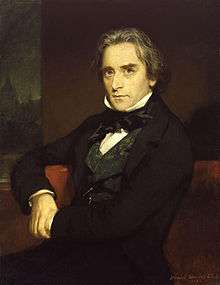
Other likely influences were a visit Dickens made to the Western Penitentiary in Pittsburgh, Pennsylvania, from 20–22 March 1842;[23] the decade-long fascination on both sides of the Atlantic with spiritualism;[12] fairy tales, and nursery stories (which Dickens regarded as stories of conversion and transformation);[5] and contemporary religious tracts about conversion.[5]
The works of Douglas Jerrold in general, but especially "The Beauties of the Police" (1843), a satirical and melodramatic essay about a father and his child forcibly separated in a workhouse, were influences,[23] and another satirical essay by Jerrold which may have had a direct influence on Dickens' conception of Scrooge, called "How Mr. Chokepear keeps a merry Christmas" (Punch, 1841).[6]
Plot
Dickens divides the book into five chapters, which he labels "staves", that is, song stanzas or verses, in keeping with the title of the book.
Stave One
%2C_opposite_25_-_BL.jpg)
The tale begins on a "cold, bleak, biting" Christmas Eve in London, exactly seven years after the death of Scrooge's business partner Jacob Marley. Scrooge, an old miser, is established within the first stave as "a squeezing, wrenching, grasping, scraping, clutching, covetous, old sinner!" He hates Christmas, calling it "humbug"; he refuses his nephew Fred's Christmas dinner invitation, and he sarcastically turns away two gentlemen who seek a donation from him to provide a Christmas dinner for the poor and needy. His only "Christmas gift" is allowing his overworked, underpaid clerk Bob Cratchit Christmas Day off with pay – which he does only to keep with social custom, Scrooge considering it "a poor excuse for picking a man's pocket every 25th of December!"
At home that night, Scrooge is visited by Marley's ghost, who is forever cursed to wander the earth dragging a network of heavy chains, forged during a lifetime of greed and selfishness. Dickens describes the apparition thus: "Marley's face ... had a dismal light about it, like a bad lobster in a dark cellar." Marley has a bandage under his chin, tied at the top of his head; "... how much greater was his horror, when the phantom taking off the bandage round its head, as if it were too warm to wear indoors, its lower jaw dropped down upon its breast!"
Marley tells Scrooge that he has one chance to avoid the same fate and that he will be visited by three spirits, one on each successive evening and that he must listen to them or be cursed to carry chains of his own that are much longer than Marley's chains. As Marley departs, Scrooge witnesses other restless spirits who now wish they could help their fellow man, but are powerless to do so. Scrooge is then visited by the three spirits Marley spoke of – each visit detailed in a separate stave – who accompany him on visits to various Christmas scenes.
Stave Two
The first of the spirits, the Ghost of Christmas Past, takes Scrooge to Christmas scenes of Scrooge's boyhood and youth, which stir the old miser's gentle and tender side by reminding him of a time when he was kinder and more innocent. These scenes portray Scrooge's lonely childhood, his relationship with his beloved sister Fan and a Christmas party hosted by his first employer Mr. Fezziwig who treated Scrooge like a son. They also portray Scrooge's neglected fiancée Belle who ends their relationship after she realises that Scrooge will never love her as much as he loves money. Then there is a visit later in time to the then-married Belle's large and happy family on Christmas Eve.
Stave Three
The second spirit, the Ghost of Christmas Present, takes Scrooge to several different scenes – a joy-filled market of people buying the makings of Christmas dinner, celebrations of Christmas in a miner's cottage and in a lighthouse. Scrooge and the Ghost of Christmas Present also visit Fred's Christmas party, where Fred tells his guests about his uncle with much laughter, but also with pity, because, "I am sorry for him; I couldn't be angry with him if I tried. Who suffers by his ill whims? Himself, always." A major part of this stave is taken up with Bob Cratchit's family feast, and introduces his youngest son, Tiny Tim, who is full of simple happiness despite being seriously ill. The spirit informs Scrooge that Tiny Tim will soon die unless the course of events changes. Before disappearing, the spirit shows Scrooge two hideous, emaciated children named Ignorance and Want. He tells Scrooge to beware the former above all, and replies to Scrooge's concern for their welfare by repeating Scrooge's own words: "Are there no prisons? Are there no workhouses?"
Stave Four

The third spirit, the Ghost of Christmas Yet to Come, shows Scrooge a Christmas Day in the future. The Ghost of Christmas Yet to Come shows Scrooge scenes involving the death of a "wretched man". The man's funeral will only be attended by local businessmen if lunch is provided. His charwoman Mrs. Dilber, his laundress, and the local undertaker steal some of his possessions and sell them to a fence named Old Joe for money. Mrs. Dilber gives Old Joe the bed curtains, the Laundress gives Old Joe the bed sheets, and the undertaker gives Old Joe some button collars. Scrooge also sees a shrouded corpse which he implores the Ghost of Christmas Yet to Come not to unmask. When Scrooge asks the ghost to show anyone who feels any emotion over the man's death, the Ghost of Christmas Yet to Come can only show him an emotion of pleasure, from a poor couple indebted to the man momentarily rejoicing that his death gives them more time to pay off their debt. After Scrooge asks to see some tenderness connected with any death, the Ghost of Christmas Yet to Come shows him Bob Cratchit and his family mourning the passing of Tiny Tim. The Ghost of Christmas Yet to Come then shows Scrooge the man's neglected grave: the tombstone bears Scrooge's name. Sobbing, Scrooge pledges to the Ghost of Christmas Yet to Come that he will change his ways in hopes that he may "sponge the writing from this stone".
Stave Five
Scrooge awakens on Christmas morning with joy and love in his heart. He spends the day with Fred's family and anonymously sends a prize turkey[24] to the Cratchit home for Christmas dinner. The following day, he gives Cratchit a raise and becomes like "a second father" to Tiny Tim. A changed man, Scrooge now treats everyone with kindness, generosity, and compassion; he now embodies the spirit of Christmas. As the final narration states, "Some people laughed to see the alteration in him, but he let them laugh, and little heeded them; for he was wise enough to know that nothing ever happened on this globe, for good, at which some people did not have their fill of laughter in the outset; and knowing that such as these would be blind anyway, he thought it quite as well that they should wrinkle up their eyes in grins, as have the malady in less attractive forms. His own heart laughed: and that was quite enough for him...it was always said of him that he knew how to keep Christmas well if any man alive possessed the knowledge." The story closes with the narrator repeating Tiny Tim's famous words: "God bless us, every one!"
Publication

Dickens began to write A Christmas Carol in September 1843.[25] The book was completed in six weeks, with the final pages written in early December.[26] The book was published on 19 December 1843.[2] As the result of a feud with his publisher over the slim earnings on his previous novel, Martin Chuzzlewit,[27] Dickens declined a lump-sum payment for the tale, chose a percentage of the profits in hopes of making more money thereby, and published the work at his own expense.[26] High production costs however brought him only £230 (equal to £20,000 today) rather than the £1,000 (equal to £89,000 today) he expected and needed, as his wife was once again pregnant.[27][28] A year later, the profits were only £744, and Dickens was deeply disappointed.[27]
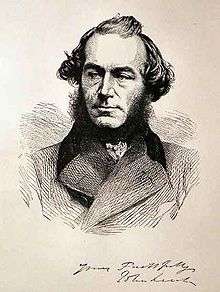
Production of the book was not without problems. The first printing contained drab olive endpapers that Dickens felt were unacceptable, and the publisher Chapman and Hall quickly replaced them with yellow endpapers, but, once replaced, those clashed with the title page, which was then redone.[16][29] The final product was bound in red cloth with gilt-edged pages,[25][26] completed only two days before the release date of 19 December 1843.[30][31]
Following publication, Dickens arranged for the manuscript to be bound in red Morocco leather and presented as a gift to his solicitor, Thomas Mitton. In 1875, Mitton sold the manuscript to bookseller Francis Harvey reportedly for £50 (equal to £4,200 today), who sold it to autograph collector, Henry George Churchill, in 1882, who, in turn, sold the manuscript to Bennett, a Birmingham bookseller. Bennett sold it for £200 to Robson and Kerslake of London, which sold it to Dickens collector Stuart M. Samuel for £300. Finally, it was purchased by J. Pierpont Morgan for an undisclosed sum. It is now held by the Pierpont Morgan Library, New York.[32][33] Four expensive, hand-coloured etchings and four black and white wood engravings by John Leech accompanied the text.[26]
Priced at five shillings (equal to £22 today),[26] the first run of 6,000 copies sold out by Christmas Eve and the book continued to sell well into the new year.[16][34] By May 1844, a seventh edition had sold out.[14] In all, 24 editions ran in its original form.[35] In spite of the disappointing profits for the author, the book was a huge artistic success, with most critics responding positively.[34]
Critical reception
The book received immediate critical acclaim. The London literary magazine, Athenaeum, declared it: "A tale to make the reader laugh and cry – to open his hands, and open his heart to charity even toward the uncharitable ... a dainty dish to set before a King."[36] Poet and editor Thomas Hood wrote, "If Christmas, with its ancient and hospitable customs, its social and charitable observances, were ever in danger of decay, this is the book that would give them a new lease. The very name of the author predisposes one to the kindlier feelings, and a peep at the Frontispiece sets the animal spirits capering".[36]
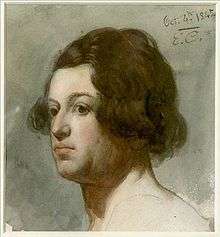
William Makepeace Thackeray in Fraser's Magazine (February 1844) pronounced the book, "a national benefit and to every man or woman who reads it, a personal kindness. The last two people I heard speak of it were women; neither knew the other, or the author, and both said, by way of criticism, 'God bless him!'" Thackeray wrote about Tiny Tim, "There is not a reader in England, but that little creature will be a bond of union between the author and him; and he will say of Charles Dickens, as the woman just now, 'GOD BLESS HIM!' What a feeling this is for a writer to inspire, and what a reward to reap!".[36]
Even the caustic critic Theodore Martin (who was usually virulently hostile to Dickens) spoke well of the book, noting it was "finely felt and calculated to work much social good".[37] A few critics registered their complaints. The New Monthly Magazine, for example, thought the book's physical magnificence kept it from being available to the poor and recommended the tale be printed on cheap paper and priced accordingly. The religious press generally ignored the tale but, in January 1884, Christian Remembrancer thought the tale's old and hackneyed subject was treated in an original way and praised the author's sense of humour and pathos.[38] Dickens later noted that he received "by every post, all manner of strangers writing all manner of letters about their homes and hearths, and how the Carol is read aloud there, and kept on a very little shelf by itself".[39] After Dickens's death, Margaret Oliphant deplored the turkey and plum pudding aspects of the book but admitted that in the days of its first publication it was regarded as "a new gospel" and noted that the book was unique in that it actually made people behave better.[37]

Americans were less enthusiastic at first. Dickens had wounded their national pride with American Notes for General Circulation and Martin Chuzzlewit, but Carol was too compelling to be dismissed, and, by the end of the American Civil War, copies of the book were in wide circulation.[40] The New York Times published an enthusiastic review in 1863, noting that the author brought the "old Christmas ... of bygone centuries and remote manor houses, into the living rooms of the poor of today", while the North American Review believed Dickens's "fellow feeling with the race is his genius"; and John Greenleaf Whittier thought the book charming, "inwardly and outwardly".[41]
For Americans, Scrooge's redemption may have recalled that of the United States as it recovered from war,[42] and the curmudgeon's charitable generosity to the poor in the final pages viewed as a reflection of a similar generosity practised by Americans as they sought solutions to poverty.[43] The book's issues are detectable from a slightly different perspective in Frank Capra's It's a Wonderful Life (1946), and Scrooge is likely an influence upon Dr. Seuss's How the Grinch Stole Christmas! (1957).[44]
Impact
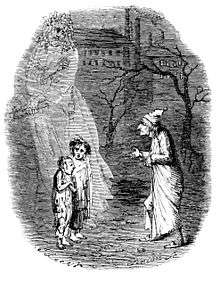
Parley's Illuminated Library pirated the tale in January 1844,[21] and, though Dickens sued and won his case, the literary pirates simply declared bankruptcy. Dickens was left to pay £700 in costs, equal to £63,000 today.[21][45] The entanglements of the various suits Dickens brought against the publishers, his resulting financial losses, and the slim profits from the sale of Carol greatly disappointed Dickens. He felt a special affection for the book's moral lesson and its message of love and generosity. In his tale of a man who is given a second chance to live a good life, he was demonstrating to his readers that they, too, could achieve a similar salvation in a selfish world that had blunted their generosity and compassion.[21]
The novella was adapted for the stage almost immediately. Three productions opened on 5 February 1844, with one by Edward Stirling sanctioned by Dickens and running for more than 40 nights.[46] By the close of February 1844, eight rival Carol theatrical productions were playing in London.[34] Stirling's version played New York City's Park Theatre during the Christmas season of 1844 and was revived in London the same year.[47] Hundreds of newsboys gathered for a musical version of the tale at the Chatham Theatre in New York City in 1844, but brawling broke out and was quelled only when offenders were led off by police to the Tombs. Even after order had been restored in the theatre, the clamorous cries of one youngster drowned out the bass drum that ushered Marley onto the stage as he rose through a trap door.[48]
_-_yt.webm.jpg)
Other media adaptations include films, a radio play, and a television version. In all, there are at least 28 film versions of the tale. The earliest surviving one is Scrooge, or, Marley's Ghost (1901), a silent British version.[49] Six more silent versions followed, with one made by Thomas Edison in 1910. The first sound version was made in Britain in 1928.[50] Other media adaptations include a popular radio play version in 1934, starring Lionel Barrymore, an American television version from the 1940s, and, in 1949, the first commercial sound recording with Ronald Colman.[51]
In the years following the book's publication, responses to the tale were published by W. M. Swepstone (Christmas Shadows, 1850), Horatio Alger (Job Warner's Christmas, 1863), Louisa May Alcott (A Christmas Dream, and How It Came True, 1882), and others who followed Scrooge's life as a reformed man – or some who thought Dickens had got it wrong and needed to be corrected.[52]

Dickens himself returned to the tale time and again during his life to tweak the phrasing and punctuation,[52] and capitalised on the success of the book by annually publishing other Christmas stories in 1844, 1845, 1846, and 1848.[53] The Chimes, The Cricket on the Hearth, The Battle of Life and The Haunted Man and the Ghost's Bargain were all based on the pattern laid down in Carol – a secular conversion tale laced with social injustice.[53] While the public eagerly bought the later books, the critics bludgeoned them.[53] Dickens himself questioned The Battle of Life's worth.[54] Dickens liked its title, though, and once considered using it for another novel which instead became A Tale of Two Cities.[55]
By 1849, Dickens was engaged with David Copperfield and had neither the time nor the inclination to produce another Christmas book.[56] Disappointed with those that followed Carol, he decided the best way to reach his audience with his "Carol philosophy" was via public readings.[57] In 1853, Carol was the text chosen for his first public dramatic reading with the performance an immense success.[17] Thereafter, he read the tale in an abbreviated version 127 times,[57] until 1870 (the year of his death), when it provided the material for his farewell performance.[17][57]
Themes
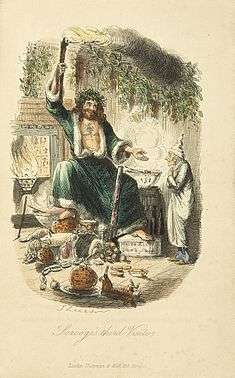
Dickens wrote in the wake of British government changes to the benefits system known as the Poor Laws, changes that required, among other things, benefits applicants to work on treadmills. Dickens asks, in effect, for people to recognise the plight of those whom the Industrial Revolution has displaced and driven into poverty, and the obligation of society to provide for them humanely. Failure to do so, the writer implies through the personification of Ignorance and Want as ghastly children, will result in an unnamed "Doom" for those who, like Scrooge, believe their wealth and status qualifies them to sit in judgement over the poor rather than to assist them.[58]
Christian themes are woven throughout the book, and the entire novella may be classified as an allegory of the Christian concept of redemption.[59] Dickens's statement that Jacob Marley "had no bowels" is a reference to the "bowels of compassion" mentioned in I John, the reason for his eternal damnation. The themes of "sinfulness to regret to repentance to salvation" are also featured throughout the novella.[60]
As the title identifies the work as a "Christmas carol", the book's chapters are called "staves" (i.e. stanzas of a song). A carol is mentioned within the narrative as part of the exposition of Scrooge's character,
- "...at the first sound of 'God bless you, merry gentlemen! May nothing you dismay!', Scrooge seized the ruler with such energy of action that the singer fled in terror, leaving the keyhole to the fog and even more congenial frost."
Restad (1995) suggested that Scrooge's redemption underscores "the conservative, individualistic and patriarchal aspects" of Dickens's "Carol philosophy" of charity (a more fortunate individual willingly looking after a less fortunate one). Personal moral conscience and individual action led in effect to a form of noblesse oblige, which was expected of those individuals of means.[43]
Legacy
While the phrase "Merry Christmas" was popularised following the appearance of the story,[61] and the name "Scrooge" and exclamation "Bah! Humbug!" have entered the English language,[62] Ruth Glancy argues the book's singular achievement is the powerful influence it has exerted upon its readers. In the spring of 1844, The Gentleman's Magazine attributed a sudden burst of charitable giving in Britain to Dickens' novella; in 1874, Robert Louis Stevenson waxed enthusiastic after reading Dickens's Christmas books and vowed to give generously; and Thomas Carlyle expressed a generous hospitality by staging two Christmas dinners after reading the book.[63] In America, a Mr. Fairbanks attended a reading on Christmas Eve in Boston, Massachusetts, in 1867, and was so moved he closed his factory on Christmas Day and sent every employee a turkey.[34] In the early years of the 20th century, the Queen of Norway sent gifts to London's crippled children signed "With Tiny Tim's Love"; Squire Bancroft raised £20,000 for the poor by reading the tale aloud publicly; and Captain Corbett-Smith read the tale to the troops in the trenches of World War I.[64]
According to historian Ronald Hutton, the current state of observance of Christmas is largely the result of a mid-Victorian revival of the holiday spearheaded by A Christmas Carol. Hutton writes that Dickens "linked worship and feasting, within a context of social reconciliation".[65] In advocating a humanitarian focus of the holiday,[7] Dickens influenced many aspects of Christmas that are celebrated today in Western culture, such as family gatherings, seasonal food and drink, dancing, games and a festive generosity of spirit.[66] With the appearance of the Oxford Movement and the growth of Anglo-Catholicism, a revival in the traditional rituals and religious observances associated with Christmastide also occurred.[67]
This simple morality tale with its pathos and theme of redemption significantly redefined the "spirit" and importance of Christmas, since, as Margaret Oliphant recalled, it "moved us all those days ago as if it had been a new gospel."[68] The tale helped resurrect a form of seasonal merriment that had been suppressed by the Puritan quelling of Yuletide pageantry in 17th-century England.[69]
Adaptations
The story has been adapted to other media including film, opera, ballet, a Broadway musical, animation, and a BBC mime production starring Marcel Marceau.[6]
References
- Footnotes
- ↑ "A Christmas carol in prose : being a ghost story of Christmas". Internet Archive.
- 1 2 "The Dickens Project". University of California, Santa Cruz. Retrieved 25 December 2013.
- ↑ Kelly 10
- 1 2 3 4 5 6 7 Kelly 12
- 1 2 3 4 Douglas-Fairhurst xxiv
- 1 2 3 4 5 Douglas-Fairhurst viii
- 1 2 Forbes, Bruce David (1 October 2008). Christmas: A Candid History. University of California Press. p. 62. ISBN 9780520258020.
What Dickens did advocate in his story was "the spirit of Christmas." Sociologist James Barnett has described it as Dickens' "Carol Philosophy," which "combined religious and secular attitudes toward to celebration into a humanitarian pattern. It excoriated individual selfishness and extolled the virtues of brotherhood, kindness, and generosity at Christmas. . . .Dickens preached that at Christmas men should forget self and think of others, especially the poor and the unfortunate." The message was one that both religious and secular people could endorse.
- 1 2 3 4 Kelly 15
- 1 2 Douglas-Fairhurst xvi
- ↑ Robert McNamara. "A Christmas Carol by Charles Dickens". About.
- ↑ "Christmas – Old Christmas – Washington Irving (1783–1859)".
- 1 2 3 4 Douglas-Fairhurst xiii
- ↑ Kelly 14
- 1 2 Andrews, Dale (20 December 2011). "Dickens' A Christmas Carol". Literary History. Washington: SleuthSayers.
- ↑ Hearn xxxii
- 1 2 3 Glancy x
- 1 2 3 Ledger 119
- ↑ Hearn xxxiii
- ↑ Hearn xxxiv
- 1 2 Restad 137
- 1 2 3 4 Kelly 19
- ↑ Slater xvi
- 1 2 Ledger 117
- ↑ lisala (20 December 2010). "Dickens' A Christmas Carol and the Question of Turkey or Goose". Real Book. Retrieved 24 July 2014.
- 1 2 Slater 43
- 1 2 3 4 5 Douglas-Fairhurst xix
- 1 2 3 Kelly 17
- ↑ Douglas-Fairhurst xx,xvii
- ↑ Douglas-Fairhurst xxxi
- ↑ Varese, Jon Michael (22 December 2009). "Why A Christmas Carol was a flop for Dickens". The Guardian. Retrieved 16 December 2011.
- ↑ Jaques, Edward Tyrrell (1914). Charles Dickens in chancery: being an account of his proceedings in respect of the "Christmas carol". Longmans, Green and Co. p. 5. Retrieved 16 December 2011.
- ↑ Douglas-Fairhurst xxx
- ↑ Hearn cv,cvi
- 1 2 3 4 Douglas-Fairhurst xx
- ↑ Glancy 17
- 1 2 3 Kelly 18
- 1 2 Glancy xii
- ↑ Hearn lvii
- ↑ Glancy xi
- ↑ Restad 136
- ↑ Restad 136–7
- ↑ Restad 138
- 1 2 Restad 139
- ↑ Restad 166,169
- ↑ Slater 44
- ↑ Standiford 168
- ↑ Standiford 169
- ↑ Nissenbaum 124
- ↑ "BFI Screenonline: Scrooge, or, Marley's Ghost (1901)".
- ↑ Kelly 28
- ↑ Standiford 171–3
- 1 2 Douglas-Fairhurst xxi
- 1 2 3 Douglas-Fairhurst xxii
- ↑ Douglas-Fairhurst xxiii
- ↑ Douglas-Fairhurst xxvi
- ↑ Douglas-Fairhurst xxvii
- 1 2 3 Douglas-Fairhurst xxviii
- ↑ Slater 1971 xiv
- ↑ "a Moore, Grace (2011). Text Guide on Charles Dickens' A Christmas Carol. Insight Publications. p. 57. ISBN 1-921411-91-0.
- ↑ Stephen Skelton, A Christmas Carol: Special Church Edition (2007); interview: Skelton, Stephen. "Reclaiming 'A Christmas Carol'". CBN. Retrieved 25 December 2013.
- ↑ Cochrane 126
- ↑ Standiford 183
- ↑ Glancy xii–xiii
- ↑ Glancy xiii
- ↑ Hutton, Ronald (15 February 2001). Stations of the Sun: A History of the Ritual Year in Britain. Oxford University Press. p. 113. ISBN 9780191578427.
- ↑ Kelly 9,12
- ↑ Ronald Hutton Stations of the Sun: The Ritual Year in England. 1996. Oxford: Oxford University Press. p. 113. ISBN 0-19-285448-8.
- ↑ Callow, 39
- ↑ Kelly, 9–10
- Works cited
- Callow, Simon (2009). Dickens' Christmas: A Victorian Celebration. frances lincoln ltd. ISBN 978-0-7112-3031-6. Retrieved 21 April 2012.
- Cochrane, Robertson (1996), Wordplay: origins, meanings, and usage of the English language, University of Toronto Press, p. 126, ISBN 0-8020-7752-8
- Dickens, Charles; Douglas-Fairhurst, Robert (ed.) (2006), A Christmas Carol and other Christmas Books, Oxford: Oxford University Press
- Dickens, Charles; Glancy, Ruth (1998) [1988], Christmas Books, Oxford World Classics, Oxford: Oxford University Press, ISBN 978-0-19-283435-5
- Dickens, Charles; Hearn, Michael Patrick (ed.) (2004), The Annotated Christmas Carol, W. W. Norton and Co., ISBN 0-393-05158-7
- Dickens, Charles; Kelly, Richard Michael (ed.) (2003), A Christmas Carol, Broadview Literary Texts, New York: Broadview Press
- Dickens, Charles; Slater, Michael (1971), The Christmas Books, New York: Penguin
- Glancy, Ruth F. (1985), Dickens' Christmas Books, Christmas Stories, and Other Short Fiction, Michigan: Garland, ISBN 0-8240-8988-X
- Hutton, Ronald (1996), Stations of the Sun: The Ritual Year in England, Oxford: Oxford University Press, ISBN 0-19-285448-8
- Kelly, Richard Michael, ed. (2003). A Christmas Carol. Broadway Press. ISBN 978-1-55111-476-7. Retrieved 21 April 2012.
- Ledger, Sally (2007), Dickens and the Popular Radical Imagination, Cambridge: Cambridge University Press, ISBN 978-0-521-84577-9
- Nissenbaum, Stephen (1996), The Battle for Christmas, New York: Vintage Books (Random House), ISBN 0-679-74038-4
- Rowell, Geoffrey (December 1993), Dickens and the Construction of Christmas, History Today, 43:12
- Restad, Penne L. (1995), Christmas in America: a History, Oxford: Oxford University Press, ISBN 0-19-510980-5
- Slater, Michael (2007), Charles Dickens, Oxford: Oxford University Press, ISBN 978-0-19-921352-8
- Standiford, Les (2008), The Man Who Invented Christmas: How Charles Dickens's A Christmas Carol Rescued His Career and Revived Our Holiday Spirits, New York: Crown, ISBN 978-0-307-40578-4
External links
| Wikiquote has quotations related to: A Christmas Carol |
| Wikisource has original text related to this article: |
| Wikimedia Commons has media related to A Christmas Carol. |
- A Christmas Carol original manuscript facsimile at Morgan Library with transcription and audio
- A Christmas Carol at Internet Archive
- A Christmas Carol e-book with illustrations
- A Christmas Carol Project Gutenberg free online book
-
 A Christmas Carol public domain audiobook at LibriVox
A Christmas Carol public domain audiobook at LibriVox - A Christmas Carol University of Glasgow Special Collections
- Jonathan Winters' A Christmas Carol (from NPR)
- Using Textual Clues to Understand A Christmas Carol
- A Christmas Carol read by Sir Patrick Stewart. (on YouTube)